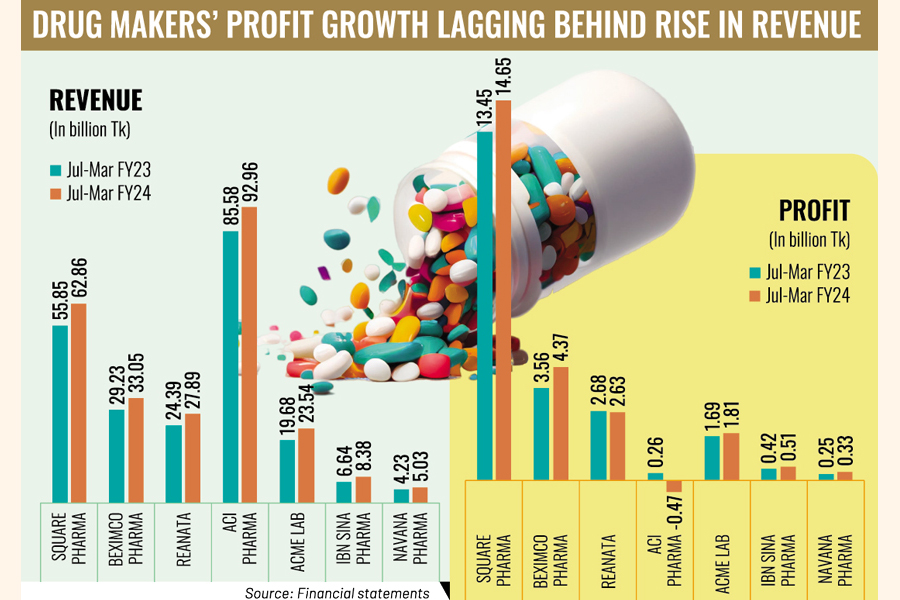Most drug makers' revenue growth fails to propel profit as much
Industry representatives mainly blame high import cost, regulatory restriction on product price hikes

Published :
Updated :

Leading drug makers showed a double-digit revenue growth year-on-year in the nine months through March this year, but the rise in their profits was much slower in comparison during the period for escalation in business cost.
Increased raw material prices, energy costs and interest expenses pushed up business costs, but the companies could not pass the entire additional costs on to consumers. Hence, the bottom-line growth narrowed, according to industry insiders.
The collective sales of seven major drug makers listed on the Dhaka Stock Exchange (DSE) grew 12.5 per cent year-on-year to Tk 254 billion in July-March of FY24. But their net profits increased only 6.8 per cent year-on-year to Tk 23.83 billion during the period, according to their unaudited financial statements.
The squeeze on profit was primarily due to higher import costs amid a strong dollar, said Mir Ariful Islam, managing director of Sandhani Asset Management.
Moreover, some drug makers' operating expenses had notably increased, but they were not able to increase medicine prices due to regulatory restrictions and so they had no scope of offsetting the extra costs, said Mr Islam.
However, there were exceptions.
Of the seven major drug makers, Navana Pharmaceuticals posted the highest profit growth of 32 per cent year-on-year for July-March of FY24. The newly-listed company has been operating on a smaller scale than others and so still has much room for growth.
Company secretary Lorens Shamol Mollick said the management had been striving to rein in operating cost as much as possible and focusing on increasing sales to offset profit erosion.
The cost of sales of Navana Pharma, which includes all associated costs to produce medicines, stood at Tk 2.74 billion in July-March this year, which was 54 per cent of total sales, down from 55 per cent of the sales in the same period a year before.
Navana Pharma prioritised production of high-end drugs, which boosted sales in the human health division. Because of the stock market listing, the drug maker also enjoyed tax benefits that helped secure a higher profit.
Square Pharmaceuticals, which comprises almost 20 per cent of the industry, more than any other drug makers, saw its revenue up 12.5 per cent year-on-year in the nine months through March, but its year-on-year profit growth was 9 per cent during the time.
Muhammad Zahangir Alam, chief financial officer of Square Pharma, explained that while their revenue surged, profitability did not rise at the same pace due to increased business costs.
The drug maker refrained from increasing prices of most products, considering that people had little disposable income amid high inflation, he said.
Out of the 700 types of medicines that the company produces, only around 10 received approvals from the drug administration for price hikes in response to a rise in cost during the period, Mr Alam added.
Nevertheless, Square Pharma was able to increase revenue ensuring more accessibility of its products in the domestic market.
To ensure wider product access, Square Pharma's year-on-year selling and distribution expenses jumped 24 per cent in July-March FY24.
On the other hand, ACI went into the red and Renata witnessed a decline in profit, having borne the burden of high finance cost.
A leading conglomerate in Bangladesh, ACI suffered a loss of Tk 474 million in the nine months through March although sales grew more than 9 per cent.
ACI blamed higher borrowing costs rendered by interest rate hikes against a fresh injection of funds for further business growth.
Its net finance costs soared 27 per cent year-on-year to Tk 4.72 billion in the nine months while the company's bank borrowings jumped 9 per cent to Tk 49.05 billion during the time.
Despite a 14 per cent surge in sales backed by higher demand for animal health products and contract manufacturing, Renata's nine-month profit dropped 2 per cent year-on-year, owing to an increase in raw materials' prices coupled with higher finance expenses.
Company secretary Jubayer Alam expressed the hope that annual profit growth by the end of the fourth quarter through June of FY24 would be satisfactory.
"As our costs increased significantly due to the devaluation of the taka, high interest expenses, and depreciation from new capital investment, we embarked on a strategic cost-management programme that has begun to yield results."
To avoid the potential risk of a further increase in interest expenses, Renata is in the process of issuing zero coupon bonds worth Tk 6.60 billion, with a five-year maturity period, to pay off outstanding short-term bank loans.
The alternative avenue for long-term financing is expected to enable the company to cut finance expenses.
Beximco Pharma gained a 23 per cent higher profit in the nine months to March this year, compared to the same period a year earlier, supported by 13 per cent revenue growth.
The drug maker managed to reduce finance costs by 11 per cent, which helped the company report a higher profit. The business strengthened its footing by launching 10 new products and registering 19 products in seven countries during the period.
IBN Sina also managed to post a double-digit profit growth.
"Despite higher input costs, the management of the company successfully kept the operating cost low," said the company in its earnings note.
The drug manufacturer's profit jumped 21 per cent year-on-year in the nine months through March this year while sales climbed 26 per cent during the time.
babulfexpress@gmail.com


 For all latest news, follow The Financial Express Google News channel.
For all latest news, follow The Financial Express Google News channel.